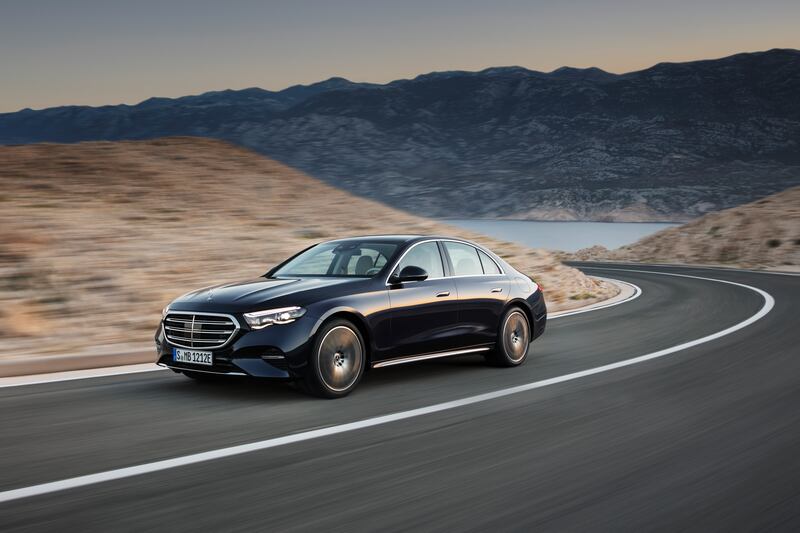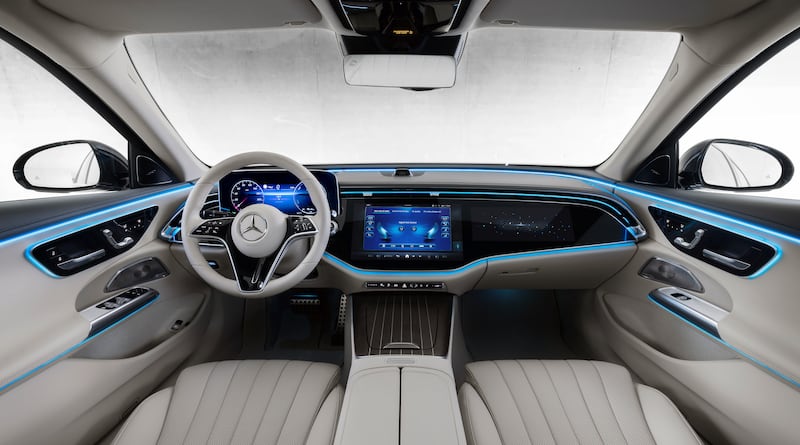Mercedes-Benz has shown off the new E-Class saloon, which will go on sale in the autumn of this year. It’s very much a continuation of the previous E-Class model, rather than a radical re-invention. Mercedes will leave the radical stuff to its EQ all-electric range for now, and this new E-Class will essentially be a more conservative stablemate to the battery-powered EQE.
That means that this new E-Class does without a fully-electric powertrain option, probably the last time that will be the case. This new W214 (for those of you who track Mercedes-Benz model codes) will come with a choice of E300e and E400e plug-in hybrids.
The E300e — also available with four-wheel drive as a 4MATIC model — uses a 2.0-litre turbocharged four-cylinder petrol engine, augmented by a 95kW electric motor and a 25kWh battery pack. Fully charge the battery, and Mercedes claims that you can go for 115km on electric power alone. The E300e’s official CO2 figure is just 12g/km, in spite of which it offers 312hp of total power, and 500Nm of torque.
The more powerful E400e uses the same engine and motor combo, but produces 380hp, with 650Nm of torque, and comes with four-wheel drive only. It has a maximum electric range of up to 109km. Thankfully the electric charging port has moved from the rear bumper, where it sat in the outgoing E-Class, to a more sensible position in the left rear wing.
READ MORE

If plugging in isn’t your thing, you can choose from a 204hp petrol E200 (effectively the E300e engine without the electrical bits) or a 194hp E220d diesel, which is also available with four-wheel drive. Both of those engines come with mild-hybrid power, which helps to trim their emissions and fuel consumption a little.
In terms of styling, the new E-Class seems like a perfect mid-point between the current C-Class and S-Class models. It’s more like the C-Class, with a tapering boot and slim brake lights, at the back and more like the S-Class — with that bulging grille — at the front. The grille, incidentally, can be optionally illuminated at night. Not sure how that will go down at the golf club…
Underneath, the E-Class can be optionally equipped with air suspension, and there’s an optional rear-wheel steering setup too, which knocks almost a metre off the turning circle.
Inside, there’s a new dashboard layout which eschews the iPad-look of the C-Class and S-Class in favour of a central screen integrated into the fascia, with a separate digital driver’s instrument panel. There’s the option of a ‘Superscreen’ (like the ‘Hyperscreen’ of the S-Class and EQS, but clearly less hyperbolic…) which adds an extra screen in front of the passenger seat, and makes it look as if it’s one continuous screen across the width of the dash.

There’s a new LED mood lighting system which can be set to pulse along with whatever music you’re playing (disco lights? In an E-Class? Whatever next…?) and an artificial intelligence system which learns your daily habits and pre-sets the cabin settings to your taste, according to what day it is, what the weather’s like, and what your schedule is. There’s also third-party app options for the main touchscreen, including TikTok, Zoom, and even Angry Birds. Oh, and you can use your iPhone or Apple Watch as a digital key, too. There’s even a selfie camera in the screen, so you can take Zoom or Webex meetings from inside the car (when safely parked, of course).
There’s an updated voice control system which supposedly recognises natural speech (believe it when we see it…) and motorised air vents which automatically swivel to heat up or cool down the cabin in the most efficient way possible.
On a more practical level, there’s more space than before, with extra legroom for rear seat passengers, and a boot that stretches to 540-litres (although Mercedes hasn’t yet confirmed if the plug-in hybrids get smaller boots, as was previously the case). If you need more practicality, there will be a new E-Class estate, although — sadly — it looks as if it may be the last of the breed, as Mercedes is all-but-inevitably focusing on SUVs from now on.
In safety terms, there’s automated emergency braking, active steering, radar-guided cruise control, and a driver’s eye tracking system that makes sure you’re paying attention to the road.
Mercedes also reckons that, in spite of not being fully-electric, this new E-Class is pretty eco-friendly. The factory it’s built in — Mercedes; Sindelfingen plant in Stuttgart — is supposedly CO2- neutral, while inside the E-Class, the seat upholstery is made from undyed alpaca wool and recycled plastics, helping to lower its carbon footprint.
Even though it’s not an electric car, the new E-Class will be hugely important to Mercedes. The German car maker has sold 16-million E-Class models (not always badged thus, but effectively E-Classes) since 1947, and it’s the mainstay of the model lineup. Will that remain true in this decade? Or will it be usurped by the electric EQ models?














